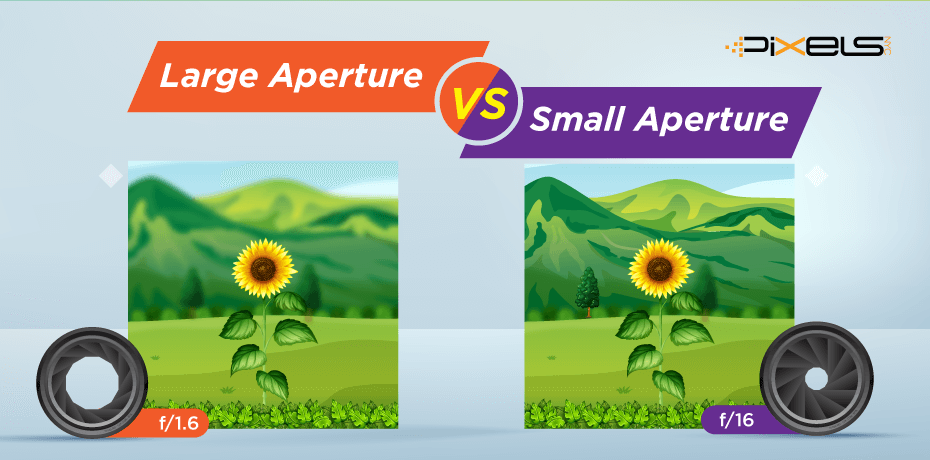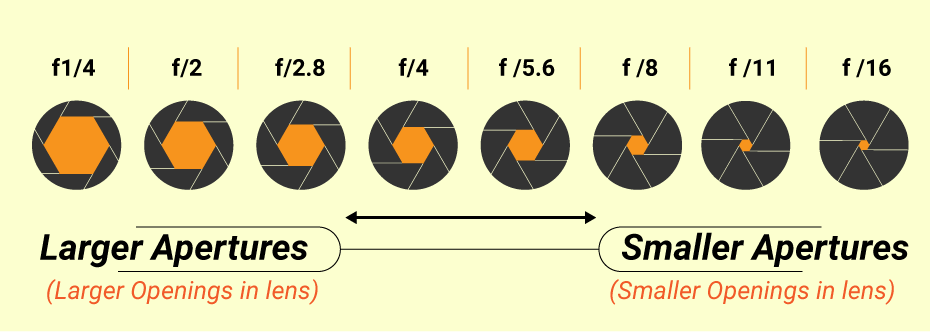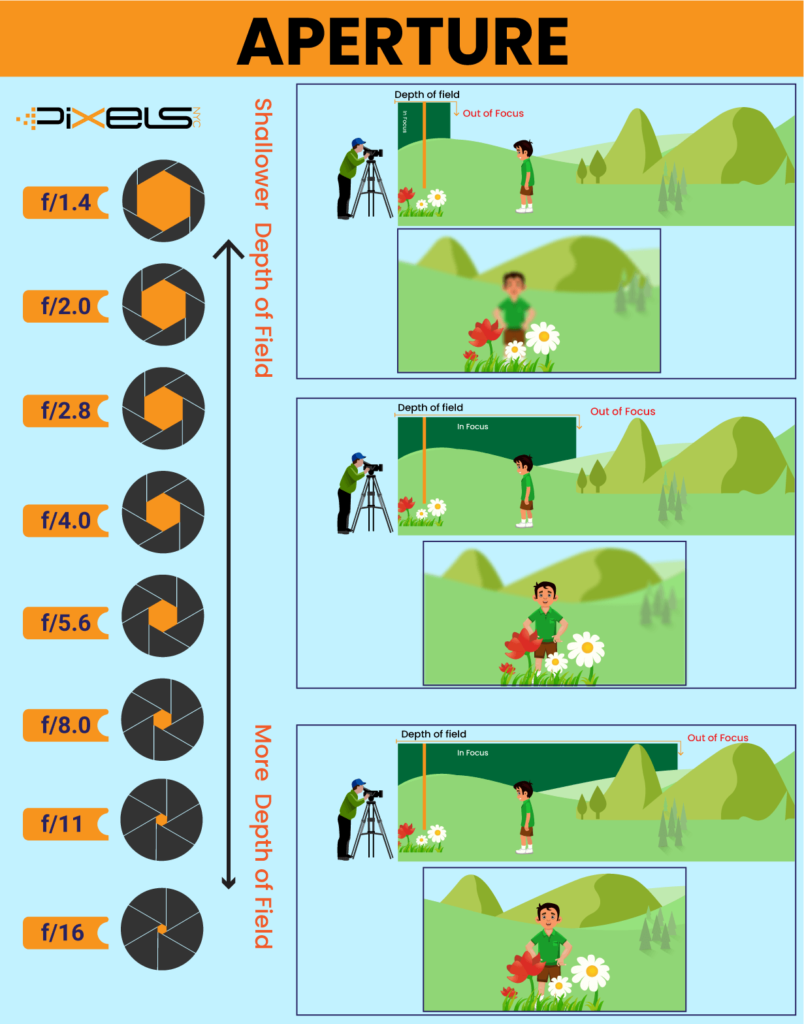Large Aperture Vs Small Aperture: Know Like A Pro!
Whether you want a detailed and artistic scenario or a smooth closeup shot with a bokeh effect, it’s all about choosing the correct aperture. Thus to make your shots look professional and impressive there’s no alternative to knowing large aperture vs small aperture settings.
Besides, understanding the subject and its surroundings is quite crucial to know which aperture to set. Worry not if you are new to the photography world. Having learned about the differences between large and small gaps will make your shots instantly more lively than before.

Concept Of Apertures In Photography
In the context of photography, aperture means the process of light entering the camera through the lens to the image processing unit. It’s a tiny adjustable hole inside the camera lens that controls the amount of light to get inside while capturing a picture.
There’s a small structure known as a diaphragm that blocks all the light escape for the light required to go through the aperture. However, the maximum and minimum aperture settings depend upon the camera brand and model.
In professional DSLR and SLR cameras, you’ll get manually adjustable physical aperture settings. Whereas, in digital cameras, the aperture can be adjusted using touch screens or buttons. For maintaining better exposure to the subject while you take a shot, setting the correct aperture is a must.
Understanding F-Numbers Of Apertures

You must have witnessed numerical units written on the lens or screen of your camera such as f/1.6 to f/16 or more. This is called the aperture number or simply the f-number. The ratio of the focal length to its aperture’s diameter is expressed in terms of F-stops or F-numbers.
Greater apertures, which let in more light, are indicated by smaller f-numbers such as f/1.6, f/2.8, etc. The quantity of light decreases by more narrow or smaller apertures, which are represented by higher f-numbers such as f/8, f/16, etc.
Since f-numbers are measured logarithmically, each increase or decrease corresponds to double or half of the total amount of light that reaches the sensor.
Understanding The Field Of Depth

As a photographer, you must have known about the two most important aspects of photography. These are the subject, background, and the distance between them. These terms are very crucial to understand camera apertures.
A lower f-number creates a shallow depth of field and mainly focuses on the subject. Hence, it creates a deep separation between the subject and the background. This creates an intensely detailed capture of the subject rather than the background.
With higher f-numbers, the aperture becomes narrower, creating an intense depth of field. Thus you can focus more on the background with a large area to capture. This intense depth of field also helps to get a detailed capture of the background far behind.
Large Aperture Vs Small Aperture
Now that you know what aperture is, let’s get in-depth about different aperture sizes and the major differences between them in photography.
| Different Aspects | Large Aperture | Small Aperture |
| F-Number | Lower | Higher |
| Depth of Field | Shallow | Intense |
| Light Quantity | More Light | Lesser Light |
| Focus on Subject | Closer Subjects | Distant Subjects |
| Bokeh Effect | Background Blurr | Foreground Blurr |
| Subject Sharpness | Higher Sharpness on closer subject | HIgher Sharpness on the background |
| Performance In Different Light Conditions | Better in low-light | Better in bright light |
| Exposure Time | Requires less time | Requires more time |
Size of Aperture And Light Exposure
Aperture size is inversely proportional to the f-number. A higher aperture means more light can enter the lens within a very short amount of time. On the contrary, a lower aperture defines a small amount of light entering the lens within the same time frame.
Focus On Subject
Large aperture gives better focus on closer objects. It creates a shallow depth of field creating a visual separation between the closer subject and distant background by blurring the background. On the other hand, smaller apertures give more attention to details on the distant subject
Exposure Time
Large aperture means the lens is wide open with a high diameter. Hence a lot of light can enter the diaphragm within a short amount of time. Therefore, the exposure time should be kept minimal, speeding upon the aperture settings.
Similarly, a small aperture requires a lot of light for better and sharp exposure. Therefore, you need to keep the exposure time more compared to large aperture shots.
Uses Of Large Aperture In Photography
In large aperture settings, you can take many impressive closeup shots depending on your subject selections. Here are some uses of large apertures in real-time photography.
Closeup Shots With Bokeh Effects
Large apertures are mostly used for close-up shots of the subjects to create isolation or separation from the background. For example, portrait images, product advertisement images, very small objects, etc are taken with large aperture (small f-number) settings.
Low-Light & Night Photography
Since a large aperture allows more light to enter it is used in low-light photography. Even at low light, you can create brighter images indoors or do astronomical images outdoors.
Motion Photography
You can use a large aperture to create a sharp image of objects in motion. Since the focus remains mainly on the subject in motion, the background gets separated eliminating the distractions due to shallow depth of field.
Associating with high shutter speed, you can take quick shots of wildlife, sports, or any object in fast motion.
Uses Of Small Aperture In Photography
Take a look at the scenarios where you can use small aperture settings during photography.
Landscape & Scenic Photography
Due to the fact that small apertures create intense depth of field, you can use them to capture eye-catching landscape images of natural and architectural sceneries.
Day-Light Images
You can set small apertures while taking shots in the daytime to avoid image burn with high contrast. Outdoor natural shots with extreme details and sharpness are good subjects for small aperture settings.
Light Burst Images
You can capture appealing images of subjects radiating light such as vehicles, sun, moon or street lights, etc. These are known as point light sources. Since a small aperture allows a lesser amount of light to enter, these types of subjects can be aesthetically captured using a small aperture.
How To Choose The Right Aperture?
Choosing the right aperture is very important to get the expected details in your captured images. Here are some pre-requisite things you need to know to set the correct aperture while taking a shot.
- Know your subject and determine the type of image you want. For example, portrait images require a larger aperture, and landscape images require a smaller aperture
- Check out the environment and the amount of light it radiates towards your camera from the object.
- Maintain the proper shutter speed and ISO along with the aperture.
- Keep an eye on the distance between the subject and the camera for proper aperture settings.
- Check if the subject is in motion and determine the aperture accordingly.